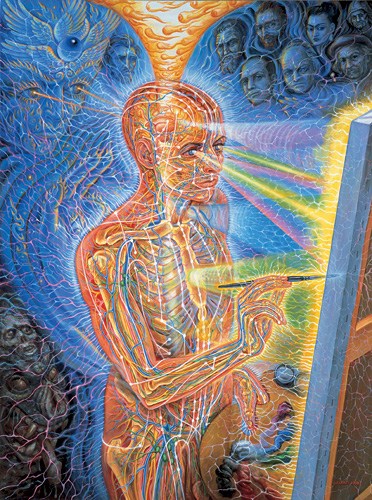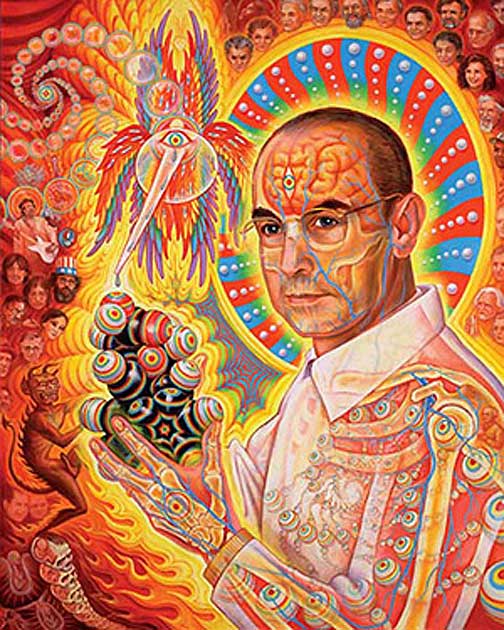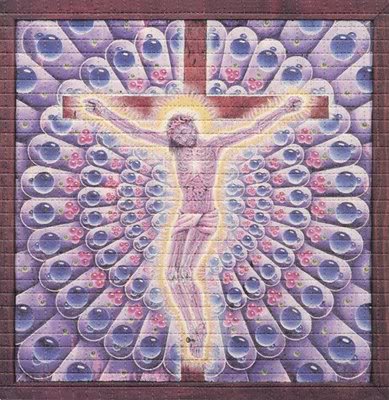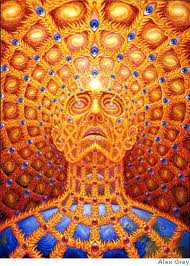by Peter Bebergal
Despite their common, and mostly fringe area of concern, the psychedelic subculture — whose kaleidoscopic reflection includes Johns Hopkins scientists, transpersonal psychologists, dozens of independent (non-affiliated) researchers, writers, visionary artists, and the users themselves — is often at odds with itself. Above board researchers take pride in their work, adhering to the strict peer review process that all science is subject to. But to some, the work of psychedelics is the work of the spirit, of the non-rational, of connecting ourselves to something that may well not be testable or empirically verifiable. There are also clashes of personality, of ideologies, and of intention. Sometimes it’s simply a disagreement over words, what they mean, and how they should be used.
At the heart of a contest of terms within a very small subculture is another more essential divergence, one that reflects a wider cultural conflict between science and spirituality.
One of the most remarkable developments in the past ten years is the trending toward acceptance in the scientific community of research involving psychedelic drugs after an almost forty year period of disregard. But like other recent fields of research, such as work done with stem cells, DNA, and even evolutionary biology, researchers find themselves up against ideas of spirituality.
The word psychedelic was coined in an attempt to more appropriately categorize those drugs capable of turning off what Aldous Huxley referred to as a filter in our brain, allowing a more undiluted experience of reality to flow in. In response to a frustration that Aldous Huxley and his friend Humphry Osmond had with words like “hallucinogen,” Osmond came up with psychedelic. In a 1957 article for the journal Annals of the New York Academy of Sciences Osmond wrote, “I have tried to find an appropriate name for the agents under discussion: a name that will include the concepts of enriching the mind and enlarging the vision…. My choice, because it is clear, euphonious, and uncontaminated by other associations, is psychedelic, mind manifesting”
Once psychedelic drugs lost their academic foothold–after Timothy Leary and Richard Albert were fired from Harvard in 1963–and the drugs themselves became illegal, psychedelic research faded into the invisible margins. But the high-minded work continued. Psychologists and others realized that if these substances were ever to again have any legitimacy they had to first undo the damage wrought by that often pesky foe to truth, language. The word psychedelic, meant to refer to those drugs that had the potential to illuminate and transform human consciousness, was now becoming a word to toss around and attach to anything that was characterized by those once ineffable qualities, far out, groovy, trippy.
By the late 1960s the term psychedelic had become so far removed from Osmond’s intended meaning that it made sense to come up with something new. And more importantly, it was becoming clear that these substances were special, not just because of their ability to mobilize a counterculture (which a wide-spread consumption of LSD did remarkably well) but because of their capacity to deliver a profound and peak spiritual experience. A new term, it was thought, must reflect this.
In 1979, for the Journal of Psychedelic Studies, Carl Ruck and a group of researchers–including the ethnobotanist Jonathan Ott and the mycologist Gordon Wasson–formulated the term “entheogen.” Taken from an obscure greek word entheos–“the god within”–entheogen was typically used to describe an ecstasis or divine madness when the god Dionysus had come calling. The authors designated entheogen as a word that is “appropriate for describing states of shamanic and ecstatic possession induced by ingestion of mind-altering drugs.” Entheogen’s usage was cemented when it became the preferred term by the Council on Spiritual Practices (CSP), the group that initiated and supported the psilocybin and mystical experience study at Johns Hopkins. CSP’s convenor, Robert Jesse, explained by phone that CSP uses the word entheogen because it connotes the more profound, insight-giving uses of the psychoactive substances to which it refers.
But many find “entheogen” to be problematic. Ethnopharmacologist Dennis McKenna, brother to the late psychedelic and speculative philosopher Terrence McKenna and a respected researcher in his own right, believes these drugs are capable of much more than inducing a mystical hierophany. The word entheogen privileges that experience over all others, but even more importantly, a true spiritual experience with these substances is a rare thing indeed. Why use a term that contains a built-in promise that cannot always be realized?
In an email McKenna explains, “Only under certain, highly controlled circumstances do they manifest ‘god within,’ whatever that means.” For the whole range of substances and the even greater range of their effects, McKenna prefers psychedelic: “I like ‘psychedelic’ even with all its cultural baggage because it reliably describes what they do: they ‘manifest’ the mind.”
Rick Doblin, founder of the Multidisciplinary Association for Psychedelic Studies (MAPS), concurs. “I never use the term “entheogen.” I feel it is positively biased to imply drugs that catalyze positive experiences of the divine, and is similar to hallucinogen that is negatively biased to imply drugs that catalyze fundamentally false and delusionary experiences.”
This disagreement over what word best expresses the possibilities of psychoactive substances such as psilocybin, mescaline, and DMT reveals how even a culture as small as those engaged in research of this kind can be split on what part of human potential should be developed. Psychedelic science is, the argument suggests, either a science of the mind or a science of the spirit.
To this muddle enter John Halpern, a professor of psychiatry at Harvard’s McLean hospital, and one of the leading above-ground researchers in psychedelic drugs. Halpern, whose studies include the long-term effects of peyote on Native Americans, has this year started a company that hopes to market a drug to those who suffer from cluster headaches, a debilitating illness. Many sufferers have found relief with LSD. Halpern is developing a drug that uses the non-psychoative derivative of LSD known as BOL-148. In what many consider a surprising move, he’s named his company Entheogen, Corp.
So why use a term for science that is loaded with spiritual meaning? By phone Halpern explained to me why he believes the word fits the intent of his company so well. People who have cluster headaches often personify their affliction as a demon or devil, and when the headache ceases, will talk in terms of having “killed the beast.” For Halpern, he is in fact offering a spiritual experience to these people, and moreover, it is through chemistry related to LSD. Halpern sees his company as offering medicine in the shamanic sense, a usage thus akin to the deeper meaning of entheogen; like psychedelic, entheogen has been co-opted from the work of serious researchers into an underground with no clear purpose or message.
It’s true that the psychedelic counterculture from the outside can often appear to be a hodgepodge of beliefs, identities and intentions, but that doesn’t mean they don’t hold some things to be universally sacred, if not essential. The author Erik Davis, well known for his mostly temperate and objective writings on psychedelic culture, finds it creepy that a drug company would try to absorb a word that essentially reflects the highest potential of the human spirit. “Maybe that’s the game we are playing now, but it tastes bad to me,” he laments. “The term already has a meaning for a fairly circumscribed world that has a very ambivalent relationship with corporate America and the law, and so it seems profoundly inappropriate. It’s rude to appropriate its most symbolic tokens.”
In the underground the emphasis is often more on the spiritual than the scientific; this is largely due to what might be the actual value of psychedelics in the first place: the experience. While science-based research might be looking for how these substances can be used to treat headaches, the energy behind it all—the users—don’t often care much about what is measurable or quantifiable. All you need to know about the value of psychedelics is your own experience, they believe. And because so much traditional use of these substances is bound up in religion, the current counterculture is seeking to make sense of its own trips by attaching this kind of spiritual significance.
So while psychedelic research can contain work that seeks to unlock both spiritual and psychological doors, a drug company might not be the best advocate for bridging what Steven Jay Gould calls non-overlapping magesteria, science and religion.
Jesse at CSP also believes that Ruck and his colleagues explicitly intended the term to designate particular psychoactive plants and chemicals. CSP has given much thought to the specialized terminology of its field, and Jesse says he is “baffled” by the use of “entheogen” in connection with non-psychoactive substances. Expressing concern about dilution of the word’s meaning, Jesse asks, “If the company is implying that its non-psychoactive cluster headache drug is an entheogen, why not also apply the label to aspirin or to penicillin?”
While acknowledging that spirituality must play out in ordinary consciousness, Jesse thinks “entheogen” should be reserved for use in connection with non-ordinary, heighted states of consciousness of spiritual import.
As for Halpern’s claim that Entheogen Corp. is, at its heart, shamanic, Jesse replies, “We can appreciate the framing of the healing arts as spiritual practice.” And yet, he is skeptical: “I’m very unconvinced that the non-psychoactive cluster headache drug in question belongs in the category ‘entheogen.’ Furthermore, one mark of authenticity of a spiritual undertaking is that it is not organized for profit. Time will tell.”
So maybe legitimacy is also an idea that can have multiple meanings. For some, the ability to do FDA approved-research is enough. For yet others, the only real legitimacy is the freedom to alter our own consciousness in whatever way we choose. For Halpern, true legitimacy will come when these substances have proven their commercial and medical viability. Which is why Rick Doblin sees no conflict at all: “[Halpern] appropriated the term ‘entheogen’ for his company to indicate his aspirations rather than the actual initial research direction of the company. The name is about marketing, not science, but since it’s for-profit, I expect marketing and don’t object.”
Halpern hopes commercial use could help bring both exposure of entheogens and their use to greater cultural acceptance. He insists he sees his work as coming from a moral imperative, and recognizes the power of both the drugs and the terminology that surrounds them. “I want to live up to using the term entheogen,” he says.
The word entheogen was not a result of slang or colloquial use. Its designation was a decidedly “scientific” endeavor; an attempt to describe those substances traditionally belonging to native peoples but whose power could help activate certain potentialities for even 21st century Westerners. More significantly the methods for evaluating their capacity should also be sound and rigorous while respecting the inherent “spiritual” nature of these drugs. But is such a thing possible in the realm of scientific, and by extension, mainstream culture? By conflating the spiritual with the pharmaceutical in the marketplace, Halpern’s company is attempting something that even the fabulously media-savvy Timothy Leary could never have dreamt of, making the loaded connotation of psychedelics synonymous with normal, capitalist-driven, American culture.
Peter Bebergal is co-author, with Scott Korb, of The Faith Between Us (Bloomsbury, 2007). His next book, a memoir/cultural history of drugs and mysticism is forthcoming from Soft Skull Press. He blogs at mysterytheater.blogspot.com.




